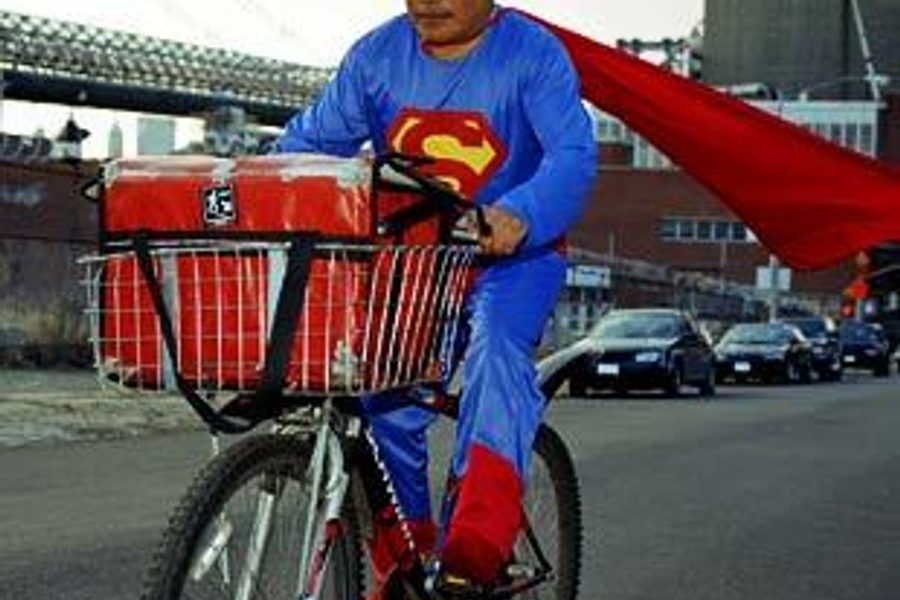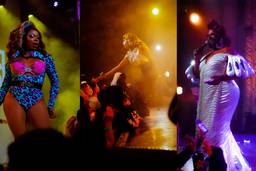
On a pleasant June evening, I’m seated across the table from photographer Dulce Pinzón in a crowded Mexican restaurant in Brooklyn. Looking over the menu while trying to come up with a few reasonably articulate questions for an interview, I notice out of my right eye a broad-shouldered worker rushing by our table. He looks strangely familiar.
“Is that … Hombre Elástico?”
Pinzón nods – it is Mr. Fantastic, the man of astounding intelligence and extreme malleability, leader of the Fantastic Four (and who, in Spanish-speaking countries, is known as the “Elastic Man”). Even without the three-foot-long forearms and the blue six-pack stomach, I remember his photo clearly, with his chubby cheeks and easy smile on display as he delivers a dish to waiting customers.
“That’s how I met many of the superheroes,” Pinzón explains, “just by running into them during my normal life. Wonder Woman (Mujer Maravilla) works at the laundromat where I wash my clothes, Superman delivered food to my apartment one day. These are people that I saw contributing in many ways to our lives, but they are also people that it’s easy to ignore, to not really notice.”
Born in Mexico City, Pinzón, 31, earned a degree in Mass Media Communications at the prestigious Universidad de Las Américas in Puebla. In 1995 she moved from Mexico to New York City, where she continued to pursue her primary passion, photography. Her latest project, “The Real Story of the Superheroes,” consists of 14 intimate portraits of immigrants at work in the Big Apple: Nanny. Construction worker. Taxi driver. Fish cleaner. Even a prostitute. All of the subjects photographed are from Mexico, and all send money back home to family members. Below each portrait is the immigrant’s name, their home state in Mexico, the year they arrived and the amount of earnings each wires across the border.
All well and good, you might say. These people work hard, and undoubtedly play important roles in the economy. But they are so easily missed in the hubbub of big-city life. Who can remember the face of the taxista who dropped you off at your destination, of the waiter who served you arroz con frijoles?
That invisibility was what Pinzón set out to highlight, and to do so, she settled on a simple yet dramatic ploy: superhero costumes. Aqua Man slices open a gigantic tuna in the back of a fish market; Superman zooms down a street on his bike, delivery food in his basket and red cape billowing in the wind; the Red Cricket (El Chapulín Colorado–a popular Mexican character) pushes a loaded wheelbarrow up a ramp at a construction site. The resulting photographs are visually arresting, portraying immigrants as both humble and proud, and they successfully bring a fresh perspective to a topic that’s usually debated within the stale confines of defensive Democrats and nativist Republicans.
Pinzón’s inspiration came when she saw a Spiderman costume for sale in a Mexican market while walking with her mother during a visit home. When she returned to New York, she began to search for potential immigrant laborers, explaining her idea and asking if they would participate. Working within what she calls a “fiction-documentary” style, she tried to find immigrants whose occupations matched a superhero’s ability. (The Incredible Hulk, for example, is a man from Guerrero named Paulino Cardoza, who unloads heavy shipments for a grocery store.) She hopes to eventually find six more people for the project, and recently received funding from the New York Foundation for the Arts to complete the exhibit. Thus far, “The Real Story of the Superheroes” has been shown in several cities in Mexico, Santa Fe, Tulsa, San Francisco and San Diego, and will be on display at the Queens Museum of Art in New York City from July 21 to Sept. 17.
Pinzón writes in her artist’s statement: “The principal objective of this series is to pay homage to these brave and determined men and women that somehow manage, without the help of any supernatural power, to withstand extreme conditions of labor in order to help their families and communities survive and prosper.” Anyone who has witnessed the occupational hazards that exist in a fish market or negotiated the treacherous terrain of potholed city streets on a bike in the rain understands such obstacles. And anyone who has journeyed to the states of southern Mexico where the immigrants in the exhibit originate – Puebla, Guerrero, Oaxaca – can quickly attest to the vital lifeline that remittances play for those left behind.
Ironically, it wasn’t until she left her native Mexico and landed in New York City that Pinzón began to really notice Mexican laborers. “I went to private schools and was very privileged, but didn’t realize it at the time,” she says. “That’s probably how it is everywhere for people like me.” Her father owns a successful construction company in Puebla, and when she was growing up, her parents were able to afford a dark room in the house where she could develop photos. Questions of privilege and class didn’t need to be studiously avoided – they went completely unnoticed.
“When I got to New York I found myself having to assimilate, and that’s when I became interested in the lives of other Mexicans,” she explains. “I suddenly saw all of these people here – my people – and at the same time I saw them doing what I was doing: blending in but also maintaining our own identities.” She also realized that even as the number of Mexicans in New York City dramatically increased – they are Gotham’s fastest growing immigrant group – they were still generally ignored by Anglos, just as she had found it easy to overlook the working-class Mexicans back home.
Along with her own struggles to assimilate and earn a living (for a period, she herself was undocumented, and worked under the table as a waitress), a key experience in her political development came when Pinzón spent two years volunteering on a local union campaign. “We were working to organize the Mexican greengrocers,” she recalls about her time spent with Local 338 of the UFCW. “And even though I loved the work, I could see that the unions weren’t ready to fully incorporate the Latinos. There was still some resistance, and this resistance meant that they weren’t using the full potential of these workers. I think that now with the recent protests around immigration, you’re finally seeing the power that we can have, if we get organized. People aren’t able to ignore the growing Latino presence in this country anymore.”
Pinzón says her most rewarding experience of the Superheroes project came when she returned to Mexico for the opening of the exhibit in Puebla. By chance, María Luisa Romero, who is from Puebla and works at a Brooklyn laundromat, was also in town to visit her parents and bring her 14-year-old daughter, Anayeli, to Brooklyn. Romero, a.k.a. Wonder Woman, came to the exhibit’s opening with Anayeli and was one of the stars of the show. “She loved it,” Pinzón remembers. “She was standing around, drinking wine and talking to people from La Jornada, El Reforma and El Universal. You should’ve seen it, her cheeks were so red!”
When I speak with Romero, she agrees. “The event was beautiful – there were so many people to meet,” she says excitedly. “Reporters took my picture and asked me all sorts of questions; everyone was very interested in the life of an immigrant.”
But when the event ended, Romero’s celebrity didn’t make the arduous task ahead any easier. She and her daughter, both born in Mexico, had to cross the busy border near Tijuana illegally. “It was very difficult to cross, because there was too much migra,” she explains. They were apprehended three times by Border Patrol agents before finally making it safely into the United States, where Anayeli now attends a bilingual high school and Romero is back at the laundromat.
“That is why I think Dulce’s project is so important,” Romero says. “Americans need to know the hardships and suffering that immigrants must go through in order to help their relatives back home.” She’s been waiting anxiously to see if an immigration reform bill emerges that could eventually grant her citizenship. Having worked in the country for six years, she is optimistic that Wonder Woman might one day be able to visit her parents without having to worry about how she’ll get back.






